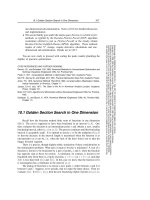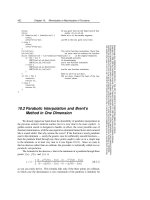Lập Trình C# all Chap "NUMERICAL RECIPES IN C" part 170 docx
Bạn đang xem bản rút gọn của tài liệu. Xem và tải ngay bản đầy đủ của tài liệu tại đây (91.15 KB, 4 trang )
402
Chapter 10. Minimization or Maximization of Functions
Sample page from NUMERICAL RECIPES IN C: THE ART OF SCIENTIFIC COMPUTING (ISBN 0-521-43108-5)
Copyright (C) 1988-1992 by Cambridge University Press.Programs Copyright (C) 1988-1992 by Numerical Recipes Software.
Permission is granted for internet users to make one paper copy for their own personal use. Further reproduction, or any copying of machine-
readable files (including this one) to any servercomputer, is strictly prohibited. To order Numerical Recipes books,diskettes, or CDROMs
visit website or call 1-800-872-7423 (North America only),or send email to (outside North America).
x0=ax; At any given time we will keep track of four
points, x0,x1,x2,x3.x3=cx;
if (fabs(cx-bx) > fabs(bx-ax)) { Make x0 to x1 the smaller segment,
x1=bx;
x2=bx+C*(cx-bx); and fill in the new point to be tried.
} else {
x2=bx;
x1=bx-C*(bx-ax);
}
f1=(*f)(x1); The initial function evaluations. Note that
we never need to evaluate the function
at the original endpoints.
f2=(*f)(x2);
while (fabs(x3-x0) > tol*(fabs(x1)+fabs(x2))) {
if (f2 < f1) { One possible outcome,
SHFT3(x0,x1,x2,R*x1+C*x3) its housekeeping,
SHFT2(f1,f2,(*f)(x2)) and a new function evaluation.
} else { The other outcome,
SHFT3(x3,x2,x1,R*x2+C*x0)
SHFT2(f2,f1,(*f)(x1)) and its new function evaluation.
}
} Back to see if we are done.
if (f1 < f2) { We are done. Output the best of the two
current values.*xmin=x1;
return f1;
} else {
*xmin=x2;
return f2;
}
}
10.2 Parabolic Interpolation and Brent’s
Method in One Dimension
We already tipped our hand about the desirability of parabolic interpolation in
the previous section’s mnbrak routine, but it is now time to be more explicit. A
golden section search is designed to handle, in effect, the worst possible case of
function minimization, with the uncooperative minimum hunted down and cornered
like a scared rabbit. But why assume the worst? If the function is nicely parabolic
near to the minimum — surely the generic case for sufficiently smooth functions —
then the parabola fitted through any three points ought to take us in a single leap
to the minimum, or at least very near to it (see Figure 10.2.1). Since we want to
find an abscissa rather than an ordinate, the procedure is technically called inverse
parabolic interpolation.
The formula for the abscissa x that is the minimum of a parabola through three
points f(a), f(b),andf(c)is
x = b −
1
2
(b − a)
2
[f(b) − f(c)] − (b − c)
2
[f(b) − f(a)]
(b − a)[f(b) − f(c)] − (b − c)[f(b) − f(a)]
(10.2.1)
as you can easily derive. This formula fails only if the three points are collinear,
in which case the denominator is zero (minimum of the parabola is infinitely far
10.2 Parabolic Interpolation and Brent’s Method
403
Sample page from NUMERICAL RECIPES IN C: THE ART OF SCIENTIFIC COMPUTING (ISBN 0-521-43108-5)
Copyright (C) 1988-1992 by Cambridge University Press.Programs Copyright (C) 1988-1992 by Numerical Recipes Software.
Permission is granted for internet users to make one paper copy for their own personal use. Further reproduction, or any copying of machine-
readable files (including this one) to any servercomputer, is strictly prohibited. To order Numerical Recipes books,diskettes, or CDROMs
visit website or call 1-800-872-7423 (North America only),or send email to (outside North America).
1
4
2
3
parabola through 1 2 3
parabola through
1 2 4
5
Figure 10.2.1. Convergenceto a minimum by inverseparabolicinterpolation. A parabola(dashedline) is
drawn through the three original points 1,2,3 on the given function (solid line). The function is evaluated
at the parabola’s minimum, 4, which replaces point 3. A new parabola (dotted line) is drawn through
points 1,4,2. The minimum of this parabola is at 5, which is close to the minimum of the function.
away). Note, however, that (10.2.1) is as happy jumping to a parabolic maximum
as to a minimum. No minimization scheme that depends solely on (10.2.1) is likely
to succeed in practice.
The exacting task is to invent a scheme that relies on a sure-but-slow technique,
like golden section search, when the function is not cooperative, but that switches
over to (10.2.1) when the function allows. The task is nontrivial for several
reasons, includingthese: (i) The housekeepingneeded to avoid unnecessary function
evaluations in switching between the two methods can be complicated. (ii) Careful
attention must be given to the “endgame,” where the function is being evaluated
very near to the roundoff limit of equation (10.1.2). (iii) The scheme for detecting a
cooperative versus noncooperative function must be very robust.
Brent’s method
[1]
is up to the task in all particulars. At any particular stage,
it is keeping track of six function points (not necessarily all distinct), a, b, u, v,
w and x, defined as follows: the minimum is bracketed between a and b; x is the
point with the very least function value found so far (or the most recent one in
case of a tie); w is the point with the second least function value; v is the previous
value of w; u is the point at which the function was evaluated most recently. Also
appearing in the algorithm is the point x
m
, the midpoint between a and b; however,
the function is not evaluated there.
You can read the code below to understand the method’s logical organization.
Mention of a few general principles here may, however, be helpful: Parabolic
interpolation is attempted, fitting through the points x, v,andw. To be acceptable,
the parabolic step must (i) fall within the bounding interval (a, b), and (ii) imply a
movement from the best current value x that is less than half the movement of the
step before last. This second criterion insures that the parabolic steps are actually
converging to something, rather than, say, bouncing around in some nonconvergent
limit cycle. In the worst possible case, where the parabolic steps are acceptable but
404
Chapter 10. Minimization or Maximization of Functions
Sample page from NUMERICAL RECIPES IN C: THE ART OF SCIENTIFIC COMPUTING (ISBN 0-521-43108-5)
Copyright (C) 1988-1992 by Cambridge University Press.Programs Copyright (C) 1988-1992 by Numerical Recipes Software.
Permission is granted for internet users to make one paper copy for their own personal use. Further reproduction, or any copying of machine-
readable files (including this one) to any servercomputer, is strictly prohibited. To order Numerical Recipes books,diskettes, or CDROMs
visit website or call 1-800-872-7423 (North America only),or send email to (outside North America).
useless, the method will approximately alternate between parabolic steps and golden
sections, converging in due course by virtue of the latter. The reason for comparing
to the step before last seems essentially heuristic: Experience shows that it is better
not to“punish” thealgorithmfor a singlebad step if it can make itup on the next one.
Another principle exemplified in the code is never to evaluate the function less
than a distance tol from a point already evaluated (or from a known bracketing
point). The reason is that, as we saw in equation (10.1.2), there is simply no
information content in doing so: the function will differ from the value already
evaluated onlyby an amount of order the roundofferror. Therefore inthe code below
you will find several tests and modifications of a potential new point, imposing this
restriction. This restriction also interacts subtly with the test for “doneness,” which
the method takes into account.
A typical ending configuration for Brent’smethod is that a and b are 2 ×x ×tol
apart, with x (the best abscissa) at the midpoint of a and b, and therefore fractionally
accurate to ±tol.
Indulge us a final reminder that tol should generally be no smaller than the
square root of your machine’s floating-point precision.
#include <math.h>
#include "nrutil.h"
#define ITMAX 100
#define CGOLD 0.3819660
#define ZEPS 1.0e-10
Here
ITMAX is the maximum allowed number of iterations; CGOLD is the golden ratio; ZEPS is
a small number that protects against trying to achieve fractional accuracy for a minimum that
happens to be exactly zero.
#define SHFT(a,b,c,d) (a)=(b);(b)=(c);(c)=(d);
float brent(float ax, float bx, float cx, float (*f)(float), float tol,
float *xmin)
Given a function
f, and given a bracketing triplet of abscissas ax, bx, cx (such that bx is
between
ax and cx,andf(bx) is less than both f(ax) and f(cx)), this routine isolates
the minimum to a fractional precision of about
tol using Brent’s method. The abscissa of
the minimum is returned as
xmin, and the minimum function value is returned as brent,the
returned function value.
{
int iter;
float a,b,d,etemp,fu,fv,fw,fx,p,q,r,tol1,tol2,u,v,w,x,xm;
float e=0.0; This will be the distance moved on
the step before last.
a=(ax < cx ? ax : cx); a and b must be in ascending order,
but input abscissas need not be.b=(ax > cx ? ax : cx);
x=w=v=bx; Initializations
fw=fv=fx=(*f)(x);
for (iter=1;iter<=ITMAX;iter++) { Main program loop.
xm=0.5*(a+b);
tol2=2.0*(tol1=tol*fabs(x)+ZEPS);
if (fabs(x-xm) <= (tol2-0.5*(b-a))) { Test for done here.
*xmin=x;
return fx;
}
if (fabs(e) > tol1) { Construct a trial parabolic fit.
r=(x-w)*(fx-fv);
q=(x-v)*(fx-fw);
p=(x-v)*q-(x-w)*r;
q=2.0*(q-r);
if (q > 0.0) p = -p;
q=fabs(q);
10.3 One-Dimensional Search with First Derivatives
405
Sample page from NUMERICAL RECIPES IN C: THE ART OF SCIENTIFIC COMPUTING (ISBN 0-521-43108-5)
Copyright (C) 1988-1992 by Cambridge University Press.Programs Copyright (C) 1988-1992 by Numerical Recipes Software.
Permission is granted for internet users to make one paper copy for their own personal use. Further reproduction, or any copying of machine-
readable files (including this one) to any servercomputer, is strictly prohibited. To order Numerical Recipes books,diskettes, or CDROMs
visit website or call 1-800-872-7423 (North America only),or send email to (outside North America).
etemp=e;
e=d;
if (fabs(p) >= fabs(0.5*q*etemp) || p <= q*(a-x) || p >= q*(b-x))
d=CGOLD*(e=(x >= xm ? a-x : b-x));
The above conditions determine the acceptability of the parabolic fit. Here we
take the golden section step into the larger of the two segments.
else {
d=p/q; Take the parabolic step.
u=x+d;
if (u-a < tol2 || b-u < tol2)
d=SIGN(tol1,xm-x);
}
} else {
d=CGOLD*(e=(x >= xm ? a-x : b-x));
}
u=(fabs(d) >= tol1 ? x+d : x+SIGN(tol1,d));
fu=(*f)(u);
This is the one function evaluation per iteration.
if (fu <= fx) { Now decide what to do with our func-
tion evaluation.if (u >= x) a=x; else b=x;
SHFT(v,w,x,u) Housekeeping follows:
SHFT(fv,fw,fx,fu)
} else {
if (u < x) a=u; else b=u;
if (fu <= fw || w == x) {
v=w;
w=u;
fv=fw;
fw=fu;
} else if (fu <= fv || v == x || v == w) {
v=u;
fv=fu;
}
} Done with housekeeping. Back for
another iteration.}
nrerror("Too many iterations in brent");
*xmin=x; Never get here.
return fx;
}
CITED REFERENCES AND FURTHER READING:
Brent, R.P. 1973,
Algorithms for Minimization without Derivatives
(Englewood Cliffs, NJ: Prentice-
Hall), Chapter 5. [1]
Forsythe, G.E., Malcolm, M.A., and Moler, C.B. 1977,
Computer Methods for Mathematical
Computations
(Englewood Cliffs, NJ: Prentice-Hall), §8.2.
10.3 One-Dimensional Search with First
Derivatives
Here we want to accomplish precisely the same goal as in the previous
section, namely to isolate a functional minimum that is bracketed by the triplet of
abscissas (a, b, c), but utilizing an additional capability to compute the function’s
first derivative as well as its value.









